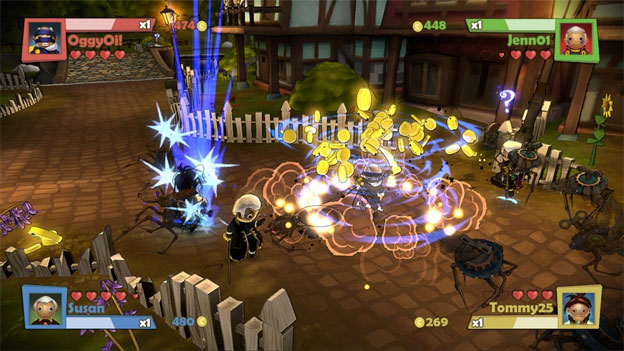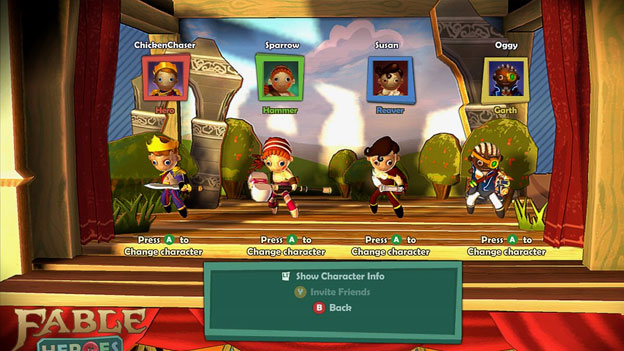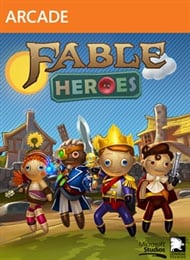Aesop Shakes His Head
Fable Heroes is a game in the unenviable spot of being a downloadable tie-in for a yet-to-be-released retail product. Further, throughout its run, the developers persist in taking the time to remind you that what you are playing is only a partial product, a shade of the whole that will exist when Fable: The Journey is in your sweaty, Kinect-owning hands.
I can’t buy it yet, Lionhead. You haven’t released it.
That said, there’s still the question of whether the ability to transfer gold from Fable Heroes to its disc-based big brother is worth it. I’m kind of getting ahead of myself, though, because I think I need to explain why I doubt Fable Heroes will succeed in enticing players to purchase Fable: The Journey. It all begins with the aesthetic.

There’s nothing wrong with a quirky or unusual art style. In fact, I might even be inclined to call Fable Heroes’ wooden puppet characters endearing, if they weren’t so creepy and gawky, clearly trying to draw upon the same appeal manifested by Miis and Sackboys. The world in which they run around is colorful, though it doesn’t really feel like anything other than generic fantasy, with the requisite lava cave, ice mountain, and idyllic farming villages to satisfy that trope. There’s a graveyard, of course, and it’s populated by some of the more demonic beasties from Fable’s menagerie of monsters, such as Balverines. That said, you won’t really recognize them; the camera is pretty distant from the action (and at a very flat angle, which makes judging depth a challenge at best; when even collecting coins is difficult, your game has perspective issues) and their designs have been retooled to fit with the game’s style, but they’re so distinct that they’re really only the same in name. That’s okay, though; the first time an enemy shows up, the game is kind enough to have its name plastered against the background in bright red letters.
Really, I think the idea with Fable Heroes is to make it like a kid’s board game. You’re playing with little doll/figurine things that, when selecting levels/minigames, you move from tile to tile on an overarching map, which appears to be set up on someone’s desk or table. Fable meets Mario Party? The only part that really plays like a board game, though, is the post-stage leveling board game, in which one must roll a die to move one’s figurine around a square, buying upgrades when one lands on spaces. There are a lot of these upgrades and they cost a lot of gold (earned through playing the levels and minigames); further, the “inner-board” upgrades only appear when at least one character on your save has purchased every possible ability from a given tile, making a special tile appear in the center. All special tiles must be unlocked before the inner board is available, making leveling a fairly linear process, hampered more by the fact that you have no control over what upgrades are available to you than anything else—want to buy a speed upgrade, but landed on an attack tile and already have everything for that? Too bad.

The question remains, though: Does the actual gameplay entice one to play through the levels, grind minigames for upgrade currency, and unlock new characters? The short answer is that no, it doesn’t. The long answer is that, while the basic beat’em up gameplay is functional, it’s immensely unsatisfying. Fable Heroes is a game designed for co-op. Specifically, it’s designed to have four players, to the point where any slots you can’t fill with a flesh and blood human will instead be taken by some of the most brain-dead (yet disturbingly greedy) A.I. I have ever seen. So the four of you traverse extremely linear side-scrolling levels, and occasionally enemies pop up so you can beat them into a puff of smoke. To do so, you have a dodge roll, a normal attack, a “flourish” attack, and your area attack, the last of which takes a heart to use, diminishing your health by at least twenty percent per use. It’s unfortunate, too, because it’s one of the more useful abilities.
Overall, combat feels unresponsive. Your puppet swings its sword or hammer, shoots its gun or magic, but enemies don’t really respond in a meaningful way—the game lacks visual and auditory feedback—and it leads to the player firing/swinging blindly in the middle of a swarm of enemies, taking unnecessary hits both due to the lack of information the game is giving you and the sluggish controls. Yes, Fable Heroes suffers from that worst of offenses: its controls are horrendously, terribly sluggish, to the point where the flourish attack, even upgraded to reduce its build-up time, isn’t worth using in any but the safest of situations. Attack speed and movement speed can both be upgraded, but the only time the game really feels the way it should is when one has stumbled upon a Super Speed power-up (power-ups as a whole are randomly gifted to whichever character opens a chest, making them mostly useless). This makes it far more playable, and it’s a shame that this wasn’t simply the default movement speed.

The strangest thing about Fable Heroes, to me, is that a series founded on the premise of freedom, of being able to define one’s own experience through the course of a grand fantasy adventure, has given birth to a stunted, would-be party game such as this in the downloadable sector.

That isn’t to say that even the Fable games under Molyneux had a particularly good history—Pub Games was pretty atrocious, feeding on the hype surrounding the second Fable to get people interested—but this seems like a real project, like it really wanted to be something interesting and enjoyable. While there are some good concepts here, and each level does branch at the end, either into a minigame or a boss battle (either of which is unlocked on the map upon completion), it feels overly rigid and barren. Its content demands replay if one actually desires completion, since its score requirements for level grades are impossible to achieve without gold-gathering upgrades and the levels must all be replayed at least once if one wishes to see every boss battle and minigame. (Though, the minigames aren’t generally worth it, extremely simplistic and rough around the edges. That said, the game does not tell you which path, at level’s end, leads to a boss and which leads to a minigame, so you’ll probably have to replay at least a few.)
And, in general, a lack of polish is the takeaway here. It’s probably best illustrated in the Gravestone level, in which my co-op buddy and I played through and found the end-level minigame to be an endless survival challenge; last player standing won the top prize (all of the minigames were competitive in the manner, and gold collected during a level is not shared, much like rupees in the Four Swords Zelda spin-offs). After our A.I. partners were knocked out, we spent almost four minutes of dreadful monotony slaying pumpkin-headed Hollow Men until, finally, one of us decided to commit suicide against an exploding pumpkin head. A game should have compelling enough gameplay that a standoff is tense and enjoyable, not dull and monotonous to the point of drudgery.
RATING OUT OF 5 RATING DESCRIPTION 3.0 Graphics
There’s a certain charm to the visuals, even if they’re neither technically nor aesthetically spectacular. That said, I still say that the dolls look creepy and the monsters are mostly unrecognizable. 1.7 Control
Sluggish and unresponsive, Fable Heroes is frustrating to play in part because it never feels like one’s character responds particularly well to one’s inputs. 2.2 Music / Sound FX / Voice Acting
It feels good when one picks up a stack of coins, but most of the sound effects are either unnoticeable or not present, since there’s also little in the way of auditory cues to alert one to what’s going on in combat. 1.5 Play Value
It really wants you to play it over and over again, since it offers incentives to do so, but it has so much difficulty maintaining one’s interest for even a single playthrough that it’s hard to think of someone wanting to do it all again, except for completion’s sake. 2.1 Overall Rating – Poor
Not an average. See Rating legend below for a final score breakdown.
| Review Rating Legend | |||
|---|---|---|---|
| 0.1 – 1.9 = Avoid | 2.5 – 2.9 = Average | 3.5 – 3.9 = Good | 4.5 – 4.9 = Must Buy |
| 2.0 – 2.4 = Poor | 3.0 – 3.4 = Fair | 4.0 – 4.4 = Great | 5.0 = The Best |
Game Features:
